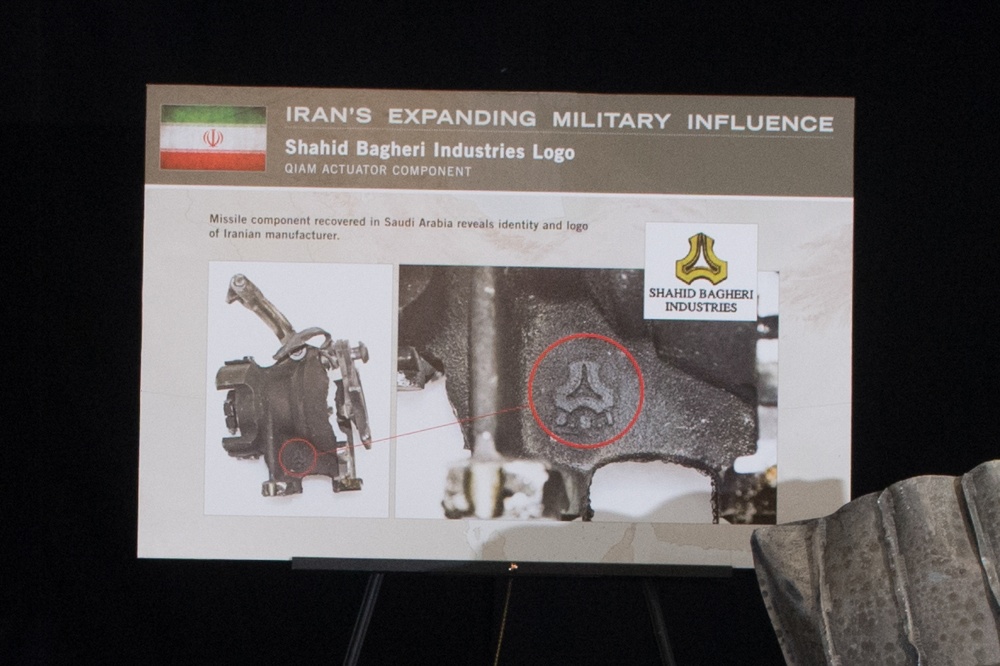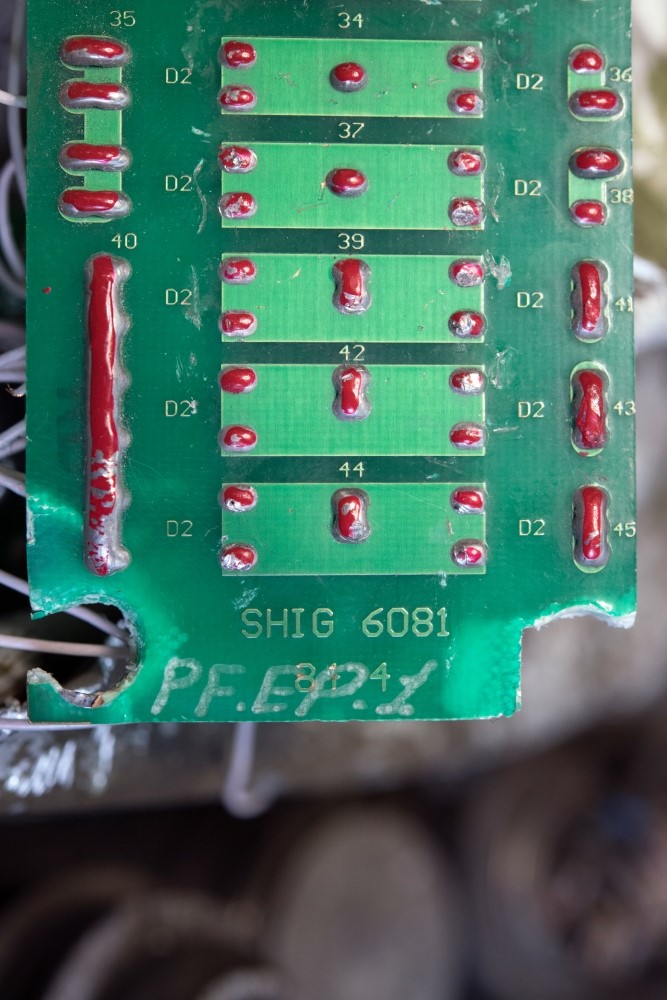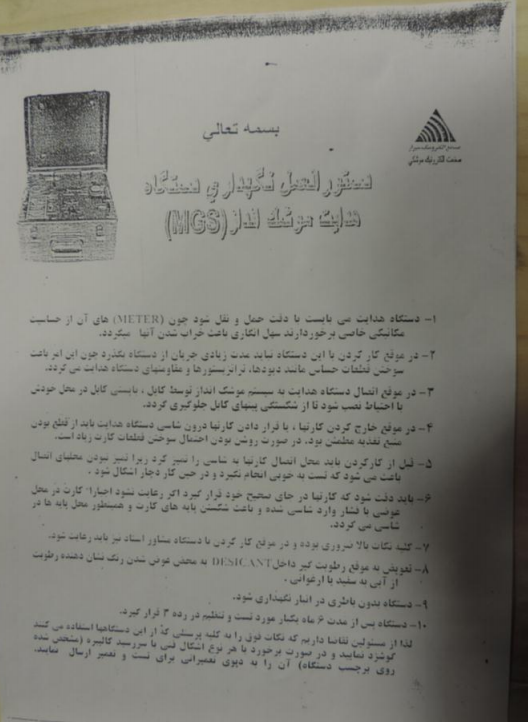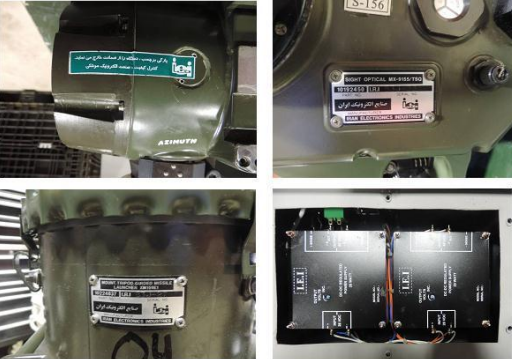Introduction
January 2018 brought with it two key recurring deadlines for U.S. President Donald Trump: whether or not to certify Iran’s compliance with the nuclear deal and whether to continue waiving nuclear-related sanctions on Iran. On January 12, the president decided for a second time not to certify Iran’s compliance, but he stopped short of re-imposing sanctions. Instead, he waived sanctions once again to allow time to “fix the deal’s disastrous flaws,” including by securing Europe’s cooperation in addressing Iran’s ballistic missile threat. The president warned, however, that this would be “a last chance” and that without progress he would “withdraw from the deal immediately.”[1]
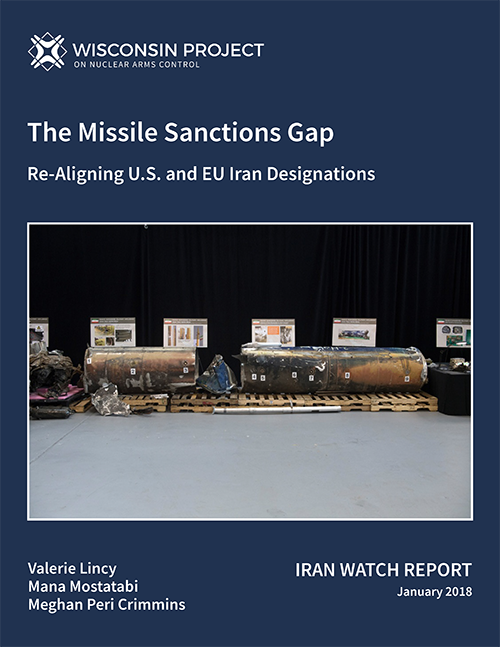
The January 12 sanctions waivers were accompanied by another round of U.S. Treasury Department sanctions, including against entities supporting Iran’s military-related procurement. Earlier in January, the Treasury Department designated five entities for their support of Iran’s solid fuel ballistic missile program.[2] These are the latest in a string of recent actions by the United States against Iranian missile proliferators, which have been taken in conjunction with sanctions targeting the Iranian government’s support for terrorism, human rights abuses, and its destabilizing regional actions.
The Sanctions Coordination Gap
The ongoing effort by the United States to identify and designate entities and suppliers supporting Iran’s missile program stands in contrast to the European Union, which has not sanctioned any Iran-related entities of proliferation concern since December 22, 2012.[3] While neither the United States nor the EU designated any entities during the height of the nuclear negotiations in 2015, the United States resumed such designations in January 2016 – just one day after the implementation of the nuclear agreement.[4]
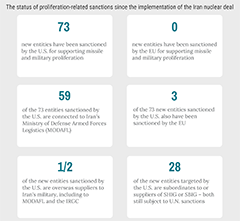
Since the agreement’s implementation, the United States has designated 73 proliferation-related entities, only three of which appear on the EU list.[5] (These entities are listed in appendix to this report.) The majority of these entities are derivative designations targeting subsidiaries and overseas networks of suppliers, front companies, and individuals acting on behalf of already designated entities. Most were targeted for supporting Iran’s ballistic missile program, with a fewer number designated for supporting Iran’s military, including through illicit procurement.[6]
In his January 12 statement, the president called on Europe to join the United States in taking “stronger steps” aimed at “constraining Iran’s missile development and stopping the proliferation of missiles, especially to Yemen.”[7] He also described ongoing efforts to work with European allies on “a new supplemental agreement that would impose new multilateral sanctions if Iran develops or tests long-range missiles.”[8]
Congress, too, has called for greater cooperation between the United States and the EU in efforts to constrain Iran’s missile development, including by coordinating proliferation designations. Such coordination was one reason for the high impact of international sanctions in the period before the 2015 nuclear agreement. The Countering America’s Adversaries Through Sanctions Act (CAATSA – P.L. 115-44), which the president signed into law last August, requires the administration to report to Congress every 180 days on the discrepancies between U.S. and EU WMD or missile proliferation sanctions.[9] The first such report is due at the end of this month.
While a number of EU member countries agree on the need to confront Iran’s missile program, all are critical of the president’s decision to tie such action to the nuclear agreement. EU foreign affairs chief Federica Mogherini repeatedly has emphasized the need to address ballistic missiles outside of the nuclear agreement, including at meetings with U.S. officials in Washington last fall.[10]
The Road to Iran’s Military
A pattern emerges in looking at the entities sanctioned by the United States for proliferation following the implementation of the nuclear agreement. Fifty-nine of the 73 entities are subsidiaries of or suppliers to a handful of well-known entities supporting Iran’s Ministry of Defense and Armed Forces Logistics (MODAFL), including Shahid Hemat Industrial Group (SHIG), Shahid Bagheri Industrial Group (SBIG). Both of these entities are subordinate to Iran’s Aerospace Industries Organization (AIO), which is “responsible for ballistic missile research, development and production activities,” according to the Treasury Department.[11] Subsidiaries and suppliers of Shiraz Electronics Industries (SEI) also have been the target of recent sanctions. SEI produces electronics for Iran’s military. It is a subsidiary of Iran Electronics Industries (IEI), which is itself controlled by MODAFL. Most of the remaining 14 entities were designated for their connection to or support of Iran’s Revolutionary Guard Corps (IRGC). All of these designations were made pursuant to Executive Order (E.O.) 13382, “which targets proliferators of WMDs and their delivery systems.”[12]
The EU, too, has sanctioned all of the well-known proliferators named above through a series of Council decisions and regulations since 2007.[13] Like the U.S. Executive Order, these authorities provide that the sanctions – including an asset freeze and prohibition on transactions – apply to those entities acting on behalf of, or owned or controlled by, those that are explicitly designated. However, the EU has failed to take action against such related entities since the nuclear agreement’s implementation. This makes it easier for Iran’s missile supply network to continue operating and undermines the impact of U.S. sanctions.
SHIG and SBIG: Key Contributors to Iran’s Ballistic Missile Program
SHIG is responsible for Iran’s liquid-fueled ballistic missile program, including the development of the medium-range Shahab-3 originally based on North Korea’s No Dong missile. SHIG also has engaged in the transfer of controlled missile technology with North Korea.[14] SBIG is responsible for Iran’s solid-fueled ballistic missile program and produces Iran’s Fateh-100 short-range missile.[15] Twenty-eight of the 73 entities designated by the United States are subordinates or suppliers to SHIG or SBIG, both of which remain subject to U.N. sanctions pursuant to Security Council resolution 2231.[16]
The U.S. focus on SBIG and SHIG increased after Iranian-backed Houthi militants in Yemen launched short-range ballistic missiles into Saudi Arabia on three separate occasions between July and December 2017. During a press conference on December 14, U.S. Ambassador to the United Nations Nikki Haley presented missile parts recovered from two of these missile strikes. One piece of missile debris was stamped with the SBIG logo and a missile guidance system component was imprinted with SHIG’s name.[17] A U.N. investigative panel for Yemen reportedly stated that Iran may be in “noncompliance” with U.N. resolutions by failing to prevent the Houthis from acquiring the missiles.[18]
Stamped logos for SHIG and SBIG appear on debris from Iranian missiles fired into Saudi Arabia from Yemen. Photos by EJ Hersom and courtesy of the Defense Video Imagery Distribution System.
The United States has continued to target subsidiaries of SHIG and SBIG, most recently on January 4, when the Treasury Department designated five entities for their role in developing and producing missile guidance systems, propellant for solid-fueled ballistic missiles, and ballistic missile launchers. All five are “owned or controlled” by SBIG.[19]
U.S. sanctions also have aimed to shut down the overseas supply networks used by SHIG and SBIG. For example, in February 2017 the Treasury Department designated a key Iranian procurement agent, Abdollah Asgharzadeh, and a network of China-based brokers and companies used by Asgharzadeh to procure dual-use technology for SHIG. The Asgharzadeh network procured and shipped foreign-produced ball bearings required for the Shahab-2 and Shahab-3 ballistic missiles.[20] Also in February 2017, the Treasury Department targeted a Dubai-based procurement network supplying SBIG with ballistic missile components.[21]
SEI: Targeting Proliferation Abroad
SEI produces electronic equipment for the Iranian military, including radars, avionics and control systems, and missile guidance technology. The firm has used front companies[22] and individuals globally[23] to obtain sensitive U.S.-origin missile-related goods and technology.[24]
Half of the 28 foreign firms sanctioned by the United States for proliferation since the nuclear agreement’s implementation were targeted for their support of SEI or its parent, IEI.[25] For example, in July 2017, the Treasury Department designated a China-based procurement agent and a network of Chinese companies she used to procure U.S.-, Canadian-, and European-origin electronic components on behalf of SEI.[26] And in May 2017, the Treasury Department designated another Chinese national and three associated China-based companies for supplying SEI with goods and technology used for missile navigation, guidance, and stabilization. Some transactions have taken place “since at least 2015,” the year of the nuclear agreement.[27]
In the Treasury Department’s most recent action on January 12, yet another China-based supply network was sanctioned for selling specialized sensors and navigational gyrocompasses to SEI.[28]
Equipment and electronic components for anti-tank missiles with SEI and IEI logos, seized while en route from Iran to Yemen. Photos courtesy of the United Nations.
SEI and IEI also have been connected to military-related exports to Yemen. In January 2016, a U.N. investigative panel concluded that weapons seized by the U.S. and Australia while en route to Yemen were likely of Iranian origin. The panel’s report noted that the weapons bore “the markings bearing the names of Iranian industrial companies” and contained photos revealing stamps belonging to SEI and IEI.[29]
The Challenges of Realignment
Since the implementation of the nuclear agreement, the EU has failed to join the United States in identifying and targeting organizations and individuals under the umbrella of entities responsible for Iran’s missile development, production, and export. More broadly, the EU has rarely pursued the overseas networks supplying missile technology to these entities. As a result, SHIG, SBIG, SEI, and others are able to circumvent sanctions more easily by using subordinates, front companies, and overseas agents to support missile development.
There are several reasons for this failure to act. First, establishing consensus among the EU’s 28 member countries is difficult. France has taken a firm stance, calling Iran’s missile program “inconsistent” with U.N. resolutions and “a destabilizing factor in the region.”[30] In a speech on January 8, President Emmanuel Macron noted that Iran’s “ballistic missile activity has been stepped up” since the 2015 nuclear agreement, and that dialogue with Iran to restrict this activity is “essential.”[31] Other countries, however, have been less forceful in calling for action.[32]
Second, the EU is concerned that any punitive action against Iran’s missile program could further undermine the nuclear agreement, which they judge as already in jeopardy as a result of the U.S. administration’s actions. In remarks last November, Mogherini said that the EU was “ready to addresses other issues,” including missiles, “once it is very clear that the nuclear deal implementation is preserved by all sides [in] full.”[33] However, the nuclear agreement and Iran’s ballistic missile program are linked; both are part of U.N. Security Council resolution 2231, which endorsed the agreement[34] and imposed restrictions on Iran’s missile and military activities.[35]
Finally, the EU has faced legal challenges to its designations in recent years. Some Iranian companies and individuals have disputed their designation in EU courts, and have had sanctions against them lifted because the information used to support the designation was confidential. Such information could not be shared openly in court and with the defendants. This may have increased the evidentiary burden required for the EU to issue additional autonomous designations, including derivative designations against subordinates and suppliers of sanctioned entities.
A Way Forward
Recent statements by U.S. and EU officials indicate a desire to work together to address the threats posed by Iran that the nuclear agreement did not contain, including Iran’s ballistic missile program. During a visit to London this week, U.S. Secretary of State Rex Tillerson announced that a working group had been set up with France, Germany, and the United Kingdom to discuss these threats and “how we might approach Iran to address our concerns.”[36] According to Tillerson, working group participants have been named and the group could meet as early as next week.[37]
In addition, French Foreign Minister Jean-Yves Le Drian will be traveling to Iran in early March to discuss Iran’s missile program along with related “regional questions.”[38] He promised to deliver a “frank message” about the need for Iran to contain its missile program as required by resolution 2231. Finally, Germany reportedly is advocating for targeted EU economic sanctions aimed at punishing Iran’s missile program.[39] If Iran refuses to curb its missile development through negotiations, a package of such sanctions reportedly may be adopted.[40] These are welcome developments. Closer collaboration between the United States and Europe increases the prospect of meaningfully restricting Iran’s missile work, whether through negotiation, economic pressure, or both.
Proliferation-Related Entities Designated by the United States since Implementation Day (January 16, 2016) Pursuant to Executive Order (E.O.) 13382, Blocking Property of Weapons of Mass Destruction Proliferators and Their Supporters^
| Entity | Date Sanctioned | Relationship, Activity, and/or Location |
|---|---|---|
| MODAFL > Aerospace Industries Organization (AIO) | ||
| Anhui Land Group Co., Limited+ | 1/17/2016 | |
| Candid General Trading LLC+ | 1/17/2016 | |
| Chen Mingfu+ | 1/17/2016 | |
| Hossein Pournaghshband | 1/17/2016 | |
| Mabrooka Trading Co. LLC+ | 1/17/2016 | |
| Rahimreza Farghadani+ | 1/17/2016 | |
| Ervin Danesh Aryan Company | 2/3/2017 | |
| Ghodrat Zargari | 2/3/2017 | |
| Mohammad Magham | 2/3/2017 | |
| Mostafa Zahedi | 2/3/2017 | |
| Zist Tajhiz Pooyesh Company | 2/3/2017 | |
| Shahid Alamolhoda Industries | 10/13/2017 | |
| MODAFL > Aerospace Industries Organization (AIO) > Shahid Bagheri Industrial Group (SBIG) | ||
| Kambiz Rostamian+ | 2/3/2017 | |
| MKS International Co. Ltd. | 2/3/2017 | |
| Royal Pearl General Trading+ | 2/3/2017 | |
| Rahim Ahmadi | 5/17/2017 | |
| Shahid Kharrazi Industries* | 1/4/2018 | |
| Shahid Moghaddam Industries | 1/4/2018 | |
| Shahid Sanikhani Industries | 1/4/2018 | |
| Shahid Shustari Industries | 1/4/2018 | |
| MODAFL > Aerospace Industries Organization (AIO) > Shahid Hemat Industrial Group (SHIG) | ||
| Sayyed Javad Musavi | 1/17/2016 | |
| Seyed Mirahmad Nooshin | 1/17/2016 | |
| Shahid Movahed Industries | 3/24/2016 | |
| Shahid Nuri Industries | 3/24/2016 | |
| Abdollah Asgharzadeh | 2/3/2017 | |
| Carol Zhou+ | 2/3/2017 | |
| Cosailing Business Trading Company Limited+ | 2/3/2017 | |
| East Star Company | 2/3/2017 | |
| Jack Qin+ | 2/3/2017 | |
| Ningbo New Century Import and Export Company, Ltd.+ | 2/3/2017 | |
| Ofog Sabze Darya Company | 2/3/2017 | |
| Richard Yue+ | 2/3/2017 | |
| Tenny Darian | 2/3/2017 | |
| Matin Sanat Nik Andishan | 5/17/2017 | |
| Amir Al MoMenin Industries | 7/28/2017 | |
| Shahid Cheraghi Industries | 7/28/2017 | |
| Shahid Kalhor Industries | 7/28/2017 | |
| Shahid Karimi Industries | 7/28/2017 | |
| Shahid Rastegar Industries | 7/28/2017 | |
| Shahid Varamini Industries | 7/28/2017 | |
| MODAFL > Iran Electronics Industries (IEI) > Shiraz Electronics Industries (SEI) | ||
| Ruan Runling+ | 5/17/2017 | |
| Shanghai Gang Quan Trade Co.+ | 5/17/2017 | |
| Shanghai North Begins International+ | 5/17/2017 | |
| Shanghai North Transway International Trading Co.+ | 5/17/2017 | |
| Abascience Tech Co. Ltd.+ | 7/18/2017 | |
| Emily Liu+ | 7/18/2017 | |
| Raybeam Optronics Co. Ltd.+ | 7/18/2017 | |
| Raytronic Corporation Limited+ | 7/18/2017 | |
| Sunway Tech Co., Ltd.+ | 7/18/2017 | |
| Wuhan Sanjiang Import and Export Co. LTD+ | 10/13/2017 | |
| Bochuang Ceramic Inc+ | 1/12/2018 | |
| Pardazan System Namad Arman (PASNA) | 1/12/2018 | |
| Shi Yuhua+ | 1/12/2018 | |
| Zhu Yuequn+ | 1/12/2018 | |
| MODAFL and Iranian Aviation Industries Organization (IAIO) | ||
| Seyed Mohammad Hashemi | 1/17/2016 | |
| Sayyad Medhi Farahi* | 1/17/2016 | |
| Morteza Farasatpour | 5/17/2017 | |
| Iran Aircraft Industries (SAHA)* | 1/12/2018 | |
| Iran Helicopter Support and Renewal Company (PANHA) | 1/12/2018 | |
| Islamic Revolutionary Guard Corps (IRGC) | ||
| Farshad Hakemzadeh | 7/18/2017 | |
| IRGC Aerospace Force Self Sufficiency Jihad Organization (ASF SSJO) | 7/18/2017 | |
| Islamic Revolutionary Guard Corps Research and Self-Sufficiency Jehad Organization (RSSJO) | 7/18/2017 | |
| Mohsen Parsajam | 7/18/2017 | |
| Qeshm Madkandaloo Shipbuilding Cooperative Co. | 7/18/2017 | |
| Rayan Roshd Afzar | 7/18/2017 | |
| Ramor Group+ | 7/18/2017 | |
| Resit Tavan+ | 7/18/2017 | |
| Seyyed Reza Ghasemi | 7/18/2017 | |
| Sadid Caran Saba Engineering Company | 9/14/2017 | |
| Fanavari Moj Khavar (Fanamoj) | 10/13/2017 | |
| Rastafann Ertebat Engineering Company | 10/13/2017 | |
| Greenwave+ | 1/12/2018 | |
| Morteza Razavi | 1/12/2018 | |
| Summary | ||
| Proliferation-related entities designated by the U.S. since implementation day | 73 | |
| Entities tracing back to MODAFL | 59 | |
| Overseas suppliers | 28 | |
| Entities designated by the U.S. since implementation day that were previously listed by the EU | 3 | |
| Key | ||
| * = Designated by the U.S. and EU | ||
| + = Overseas supplier | ||
Attachment:
![]() The Missile Sanctions Gap: Re-Aligning U.S. and EU Iran Designations
The Missile Sanctions Gap: Re-Aligning U.S. and EU Iran Designations
Footnotes:
[1] “Statement by the President on the Iran Nuclear Deal,” The White House, Press Release, January 12, 2018. (https://www.whitehouse.gov/briefings-statements/statement-president-iran-nuclear-deal)
[2] “Treasury Sanctions Iranian Entities,” U.S. Department of the Treasury, Press Release, January 4, 2018. (https://home.treasury.gov/news/press-releases/sm0246)
[3] “European Union Restrictive Measures (sanctions) in Force,” European Commission, August 4, 2017.
(https://eeas.europa.eu/sites/eeas/files/restrictive_measures-2017-08-04.pdf); “European Union Consolidated Financial Sanctions List,” European Commission, January 12, 2018. (PDF download: https://webgate.ec.europa.eu/europeaid/fsd/fsf/public/files/pdfFullSanctionsList/content?token=dG9rZW4tMjAxNw); several entities previously designated for proliferation were re-designated by the EU after 2012, following unsuccessful legal appeals, including Sharif University of Technology.
[4] “Treasury Sanctions Those Involved in Ballistic Missile Procurement for Iran,” U.S. Department of the Treasury, Press Release, January 17, 2016. (https://www.treasury.gov/press-center/press-releases/Pages/jl0322.aspx)
[5] Kenneth Katzman, “Iran Sanctions,” Congressional Research Service, pp. 79-80, January 10, 2018. (https://fas.org/sgp/crs/mideast/RS20871.pdf); “Treasury Sanctions Individuals and Entities for Human Rights Abuses and Censorship in Iran, and Support to Sanctioned Weapons Proliferators,” U.S. Department of the Treasury, Press Release, January 12, 2018. (https://home.treasury.gov/news/press-releases/sm0250); European Union Consolidated Financial Sanctions List, European Commission, January 12, 2018. (https://webgate.ec.europa.eu/europeaid/fsd/fsf/public/files/pdfFullSanctionsList/content?token=dG9rZW4tMjAxNw)
[6] “Treasury Targets Persons Supporting Iranian Military and Iran’s Islamic Revolutionary Guard Corps,” U.S. Department of the Treasury, Press Release, July 18, 2017. (https://www.treasury.gov/press-center/press-releases/Pages/sm0125.aspx)
[7] “Statement by the President on the Iran Nuclear Deal,” The White House, Press Release, January 12, 2018. (https://www.whitehouse.gov/briefings-statements/statement-president-iran-nuclear-deal)
[8] “Statement by the President on the Iran Nuclear Deal,” The White House, Press Release, January 12, 2018. (https://www.whitehouse.gov/briefings-statements/statement-president-iran-nuclear-deal)
[9] Countering America’s Adversaries Through Sanctions Act (H.R.3364), Pub. L. No. 115-44, (2017). (https://www.treasury.gov/resource-center/sanctions/Programs/Documents/hr3364_pl115-44.pdf)
[10] “Remarks by High Representative/Vice-President Federica Mogherini upon arrival at the NATO Defence Ministers’ meeting,” European External Action Service, Press Release, November 8, 2017. (https://eeas.europa.eu/headquarters/headquarters-Homepage/35311/remarks-high-representativevice-president-federica-mogherini-upon-arrival-nato-defence); “Remarks by Federica Mogherini on the implementation of the Joint Comprehensive Plan of Action (Iran Nuclear Deal),” European External Action Service, Press Release, October 16, 2017. (https://eeas.europa.eu/headquarters/headquarters-homepage/33997/remarks-federica-mogherini-implementation-joint-comprehensive-plan-action-iran-nuclear-deal_en)
[11] “Fact Sheet: Designation of Iranian Entities and Individuals for Proliferation Activities and Support for Terrorism,” U.S. Department of the Treasury, Press Release, October 25, 2007. (https://www.treasury.gov/press-center/press-releases/Pages/hp644.aspx)
[12] “Executive Order 13382 – Blocking Property of Weapons of Mass Destruction Proliferators and Their Supporters,” The White House, Federal Register, Vol. 70, No. 126, July 1, 2005, pp. 38567-38570 (https://www.treasury.gov/resource-center/sanctions/Documents/whwmdeo.pdf)
[13] “Council Regulation (EC) No 423/2007 of 19 April 2007 concerning restrictive measures against Iran,” Official Journal of the European Union, L 103/1, April 19, 2007. (http://eur-lex.europa.eu/legal-content/EN/TXT/?qid=1516654909072&uri=CELEX:32007R0423); “Commission Regulation (EC) No 441/2007 of 20 April 2007 amending Council Regulation (EC) No 423/2007 concerning restrictive measures against Iran,” Official Journal of the European Union, L 104/28, April 20, 2007 (http://eur-lex.europa.eu/legal-content/EN/TXT/?qid=1516654790317&uri=CELEX:32007R0441); “Council Regulation (EC) No 267/2012 of 23 March 2012 concerning restrictive measures against Iran and repealing Regulation (EU) No 961/2010,” Official Journal of the European Union, L 88/1, March 23, 2012 (http://eur-lex.europa.eu/legal-content/EN/TXT/?uri=celex%3A32012R0267); “Council Decision 2012/168/CFSP of 23 March 2012 amending Decision 2011/235/CFSP concerning restrictive measures directed against certain persons and entities in view of the situation in Iran,” Official Journal of the European Union, L 87/85, March 24, 2012. (http://eur-lex.europa.eu/eli/dec/2012/168(1)/oj)
[14] “Remarks at a Press Conference on Iranian Arms Exports,” United States Mission to the United Nations, December 14, 2017. (https://usun.state.gov/remarks/8215)
[15] “Treasury Designates U.S. and Chinese Companies Supporting Iranian Missile Proliferation,” U.S. Department of the Treasury, Press Release, June 13, 2006. (https://www.treasury.gov/press-center/press-releases/Pages/js4317.aspx); “Treasury Sanctions Iranian Entities,” U.S. Department of the Treasury, Press Release, January 4, 2018. (https://home.treasury.gov/news/press-releases/sm0246)
[16] “The List established and maintained pursuant to Security Council res. 2231 (2015),” United Nations Security Council, 2015. (https://scsanctions.un.org/en/?keywords=iran).
[17] “Evidence Shows Iranian Weapons Proliferation [Image 2 of 68],” Defense Video Imagery Distribution System, December 12, 2017. (https://www.dvidshub.net/image/4030006/evidence-shows-iranian-weapons-proliferation); “Evidence Shows Iranian Weapons Proliferation [Image 37 of 68],” Defense Video Imagery Distribution System, December 12, 2017. (https://www.dvidshub.net/image/4029684/evidence-shows-iranian-weapons-proliferation)
[18] Kareem Fahim, “U.N. probe details fallout of proxy war in Yemen between Saudi coalition and Iran,” Washington Post, January 11, 2018. (http://wapo.st/2AQLktC?tid=ss_tw&utm_term=.fb935292b69f)
[19] U.S. Department of the Treasury, Press Release, “Treasury Sanctions Iranian Entities,” January 4, 2018. (https://home.treasury.gov/news/press-releases/sm0246)
[20] “Treasury Sanctions Supporters of Iran’s Ballistic Missile Program and Iran’s Islamic Revolutionary Guard Corps – Qods Force,” U.S. Department of the Treasury, Press Release, February 3, 2017. (https://www.treasury.gov/press-center/press-releases/Pages/as0004.aspx)
[21] “Treasury Sanctions Supporters of Iran’s Ballistic Missile Program and Iran’s Islamic Revolutionary Guard Corps – Qods Force,” U.S. Department of the Treasury, Press Release, February 3, 2017. (https://www.treasury.gov/press-center/press-releases/Pages/as0004.aspx)
[22] “Treasury Designates Iranian Military Firms,” U.S. Department of the Treasury, Press Release, September 17, 2008. (https://www.treasury.gov/press-center/press-releases/Pages/hp1145.aspx)
[23] “Treasury Sanctions Iranian Defense Officials and a China-Based Network for Supporting Iran’s Ballistic Missile Program,” U.S. Department of the Treasury, Press Release, May 17, 2017. (https://www.treasury.gov/press-center/press-releases/Pages/sm0088.aspx)
[24] “Treasury Sanctions Iranian Defense Officials and a China-Based Network for Supporting Iran’s Ballistic Missile Program,” U.S. Department of the Treasury, Press Release, May 17, 2017. (https://www.treasury.gov/press-center/press-releases/Pages/sm0088.aspx)
[25] Kenneth Katzman, “Iran Sanctions,” Congressional Research Service, pp. 79-80, January 10, 2018. (https://fas.org/sgp/crs/mideast/RS20871.pdf); “Treasury Sanctions Individuals and Entities for Human Rights Abuses and Censorship in Iran, and Support to Sanctioned Weapons Proliferators,” U.S. Department of the Treasury, Press Release, January 12, 2018. (https://home.treasury.gov/news/press-releases/sm0250)
[26] “Treasury Targets Persons Supporting Iranian Military and Iran’s Islamic Revolutionary Guard Corps,” U.S. Department of the Treasury, Press Release, July 18, 2017. (https://www.treasury.gov/press-center/press-releases/Pages/sm0125.aspx)
[27] “Treasury Sanctions Iranian Defense Officials and a China-Based Network for Supporting Iran’s Ballistic Missile Program,” U.S. Department of the Treasury, Press Release, May 17, 2017. (https://www.treasury.gov/press-center/press-releases/Pages/sm0088.aspx)
[28] “Treasury Sanctions Individuals and Entities for Human Rights Abuses and Censorship in Iran, and Support to Sanctioned Weapons Proliferators,” U.S. Department of the Treasury, Press Release, January 12, 2018. (https://home.treasury.gov/news/press-releases/sm0250)
[29] “Letter dated 22 January 2016 from the Panel of Experts on Yemen established pursuant to Security Council resolution 2140 (2014) addressed to the President of the Security Council,” United Nations, S/2016/73, Annex 13. (https://digitallibrary.un.org/record/819771/files/S_2016_73-EN.pdf)
[30] “Iran – Mr. Le Drian’s participation in a ministerial meeting with Javad Zarif,” France Diplomatie, Press Release, January 11, 2018. (https://www.diplomatie.gouv.fr/en/country-files/iran/events/article/iran-mr-le-drian-s-participation-in-a-ministerial-meeting-with-javad-zarif)
[31] “French President’s New Year Greetings,” France Diplomatie, Speeches and Statements, January 4, 2018. (http://basedoc.diplomatie.gouv.fr/exl-php/util/Kiosque/FranceDiplomatie/kiosque.php?type=baen)
[32] “EU/E3 meets Iran: nuclear agreement in the international community’s interest,” Germany Federal Foreign Office, Press Release, January 11, 2018. (https://www.auswaertiges-amt.de/en/aussenpolitik/laenderinformationen/iran-node/-/1302392); “Statement on Nuclear Disarmament by Ambassador Michael Biontino, Permanent Representative of Germany to the Conference on Disarmament,” Permanent Mission of the Federal Republic of Germany to the United Nations, Press Release, October 13, 2017. (https://new-york-un.diplo.de/un-en/news-corner/20171013-biontino-disarmament/971436)
[33] “Remarks by High Representative/Vice-President Federica Mogherini upon arrival at the NATO Defence Ministers’ meeting,” European External Action Service, Press Release, November 8, 2017. (https://eeas.europa.eu/headquarters/headquarters-Homepage/35311/remarks-high-representativevice-president-federica-mogherini-upon-arrival-nato-defence)
[34] “Background,” Resolution 2231 (2015), U.N. Security Council. (http://www.un.org/en/sc/2231/)
[35] “Ballistic missile-related transfers and activities,” Resolution 2231 (2015), U.N. Security Council. (http://www.un.org/en/sc/2231/restrictions-ballistic.shtml)
[36] “Remarks With United Kingdom Foreign Secretary Boris Johnson at a Press Availability,” U.S. Department of State, Press Release, January 22, 2018. (https://www.state.gov/secretary/remarks/2018/01/277569.htm)
[37] Matthew Lee, “Tillerson sees progress in fixing Iran nuclear deal with Europeans,” January 22, 2018, Associated Press. (https://www.pbs.org/newshour/politics/tillerson-sees-progress-in-fixing-ira)
[38] Entretien de Jean-Yves Le Drian, ministre de l’Europe et des Affaires étrangères, avec Le Figaro, French Ministry of Foreign Affairs, January 22, 2018. (https://www.diplomatie.gouv.fr/fr/les-ministres/jean-yves-le-drian/presse-et-medias/article/entretien-de-jean-yves-le-drian-ministre-de-l-europe-et-des-affaires-etrangeres)
[39] “Berlin Supports New Iran Sanctions – German Government to Accommodate Trump to Rescue Nuclear Deal,” Der Spiegel, January 20, 2018.
[40] John Irish, Robin Emmott, and Arshad Mohammed, “Spurned by Trump, Europeans ponder how to meet Iran ultimatum,” Reuters, January 21, 2018. (https://www.reuters.com/article/us-iran-nuclear-eu-usa/spurned-by-trump-europeans-ponder-how-to-meet-iran-ultimatum-idUSKBN1FA0S4)


